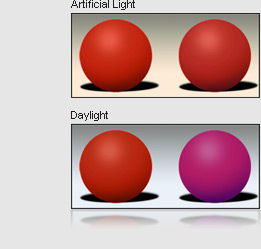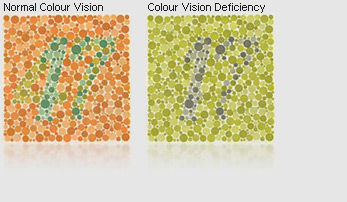About Colour
Human colour perception is very subjective and highly inconsistent. You can simply not trust your eyes.
Try it yourself. Drag and drop the squares in each row to arrange them by hue and brightness order:
Many environmental factors impact colour perception
- Ambient light (metamerism)
- Clothes you wear and ambient white point
- Surrounding objects
- Texture
- Colour blindness
- Your age (retina exhaustion)
 All light sources are a mix of several light components. Objects react to or absorb these light components in a different way, hence objects reveal different colours.
All light sources are a mix of several light components. Objects react to or absorb these light components in a different way, hence objects reveal different colours.
Have you ever compared two garments in a store and decided they matched, only to find that when you left the store and went out into daylight they no longer matched and instead looked quite different?
 If so, you have seen an optical phenomenon called metamerism. Strictly speaking, metamerism occurs when you see two samples match under one light source (illuminant) and not match under another.
If so, you have seen an optical phenomenon called metamerism. Strictly speaking, metamerism occurs when you see two samples match under one light source (illuminant) and not match under another.
Colour blindness is the inability to distinguish the differences between certain colours. This condition results from an absence of colour-sensitive pigments.
Why is a dedicated colour accurate display necessary?
The demands on the creative industry have changed considerably in recent years, with an increasing recognition and protective attitude of leading corporates towards their brand colours, such that no serious graphic designer can afford to not have a colour flow and colour handling process.
There are many different types of LCD monitors, however the display properties of the monitor are very important for the accurate display and proper handling of colour. Of the many adjustable colour settings ‘Brightness’ and ‘Colour Temperature’ are especially important. Effective colour management requires monitors with accurate colour reproduction. NEC MultiSync® PA series displays guarantee the highest standards of colour replication and will quickly repay their original investment cost.